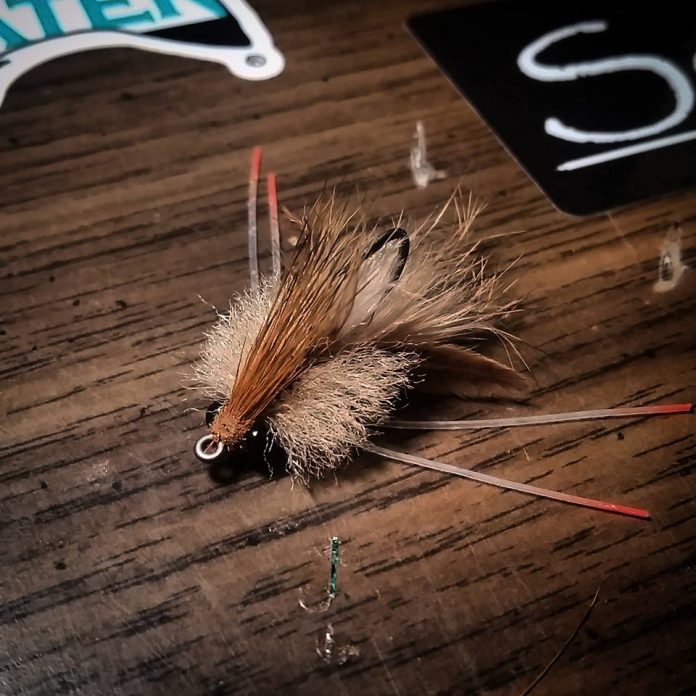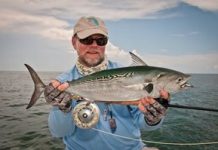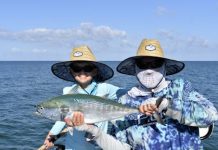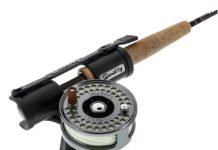Reds, Shallow Water, Fly Rod
By CAPT. PAT DAMICO, Fly Fishing Editor

Redfish are not very temperature sensitive. Winter’s low tides and clear water offer some unusual fishing opportunities that almost combine fishing with hunting. If you like a challenge, the best fishing of the year may be here. You can find and catch numbers of fish that are trapped in some deeper “hole” waiting for the incoming tide. The rising water will allow them to spread out across some adjacent flat where feeding opportunities are abundant. If you are up for a one on one challenge in skinny water your best opportunity is now.
A thorough knowledge of your quarry and their habits will help immensely. How do you recognize them, where do you look, what do you use, how not to spook them, are just a few of the challenges that you accept. A red’s low slung mouth is perfect for bottom feeding. He can push and disrupt the bottom in his search for food. His interest in the bottom can be your opportunity to get up close and personal.
I love to find and pursue tailing redfish. A slow moving tail sticking out of the water will get your attention. Mullet tails are transparent, pointed, and only show quickly for a second. Reds will be found on flats that have their favorite food, like crabs and crustaceans. Wading birds often precede fish looking for the same staples. A concentration of birds actively feeding in the shallows will often have redfish mixed in with them. Watch these birds to see how you should reduce your visibility. Duplicating their movements will allow you to get close. It is rare to find schools of mullet that don’t have reds as opportunistic companions, waiting for mullet movement to flush their next meal. I often pole my skiff to the edge of a flat I want to fish, anchor and wade. Wading will increase your chances of getting closer.
Don’t be in a big hurry to cast. Watch to make sure you know the exact position of the fish. Is he facing you, or facing left or right? If facing away, there is a good chance you will line him spooking him and any friends he has nearby. When his head is down in the bottom, his tail is usually up and this will be your best opportunity to cast. Get the fly close, but not too close. If the fly makes it to the bottom without a take, move it only an inch when he gets his head out of the mud. A six inch strip will scare him. If the fish is moving, cast ahead of the fish, and let the fly sit on the bottom. As the fish gets within a foot, or two, begin to move the fly just enough to get his attention. Keeping the rod tip close to the waters surface and eliminating slack is most important. Reward his take with a strip strike.
Florida has many crabs. Blue, fiddler, hermit, speckled, spider, mole and sand are just a few. How do we select and fish an effective crab pattern. Your casting skills better be adequate, because accuracy is more important than distance. Eight weight rods, or lighter in calm conditions, can deliver a crab pattern with a floating line. Nine foot leaders are a minimum, usually tapered to twelve pound test fluorocarbon.
Fly selection will include flies that will not spook shallow water fish. Small lead dumbbell, bead chain, and plastic eyes when properly mounted on a hook also stabilize the crab making it sit at rest with the hook point up. These eyes, mounted in the front allow the crab to seem to dive for the bottom when in danger. Shape your crab pattern so that it is a little narrower in the front where the weight is allowing it to dive and not wobble as it descends. The crabs color should match the bottom. If fishing sand, tan will predominate. When in turtle grass, a greenish color works best. My one exception to this rule is when fishing a mylar crab. They are gold and copper colored and are especially useful when water is discolored. Weed guards are also necessary most of the time. The crab pattern should not make much noise when hitting the water. A pattern make of wool will be more silent than a mylar or epoxy crab. Your casting skills will help most here. Watch the fish’s reaction to your casts, and adjust weight accordingly. Smaller is better when selecting crab flies. A size two or four will often work best.
Tailing redfish are not easy. A large red in skinny water presents a formidable challenge. Fooling him will give you a great sense of satisfaction and exhilaration. Try not to shout for joy when you finally connect.
Capt. Pat Damico, a FFF certified fly casting instructor, guides in lower Tampa Bay as well as surrounding water offering fly and light tackle trips. To see how to tie a Mylar crab and Kwan crab, go to fishbuzz.tv and under flies you will find a video of him tying these and other favorites. His website www.captpat.com offers additional information.
- Captain’s Corner:Pat Damico - June 25, 2019
- Flat water makes seeing tarpon easier - May 17, 2017
- Warm rivers holding plenty of targets for fly fishermen - February 16, 2017











